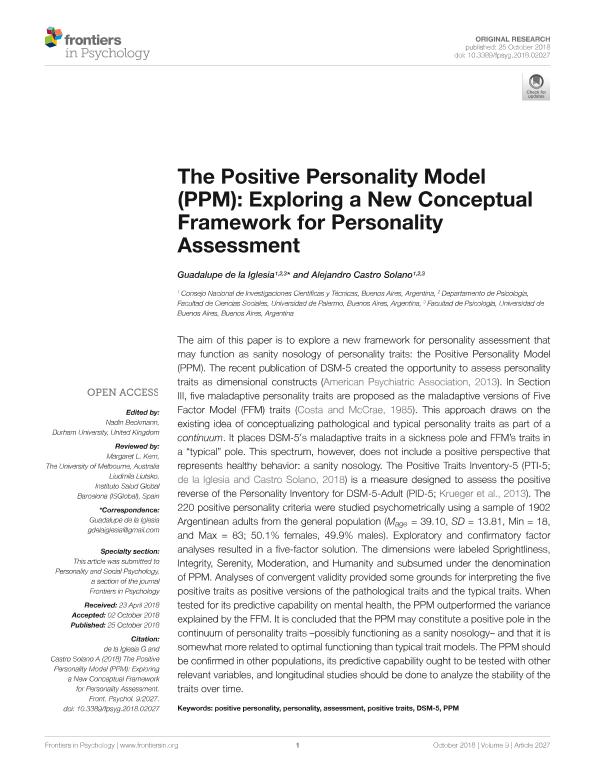Mostrar el registro sencillo del ítem
dc.contributor.author
de la Iglesia, Guadalupe

dc.contributor.author
Castro Solano, Alejandro

dc.date.available
2022-11-15T12:50:31Z
dc.date.issued
2018-10
dc.identifier.citation
de la Iglesia, Guadalupe; Castro Solano, Alejandro; The positive personality model (PPM): Exploring a new conceptual framework for personality assessment; Frontiers Media; Frontiers in Psychology; 9; 10-2018; 1-13
dc.identifier.issn
1664-1078
dc.identifier.uri
http://hdl.handle.net/11336/177796
dc.description.abstract
The aim of this paper is to explore a new framework for personality assessment that may function as sanity nosology of personality traits: the Positive Personality Model (PPM). The recent publication of DSM-5 created the opportunity to assess personality traits as dimensional constructs (American Psychiatric Association, 2013). In Section III, five maladaptive personality traits are proposed as the maladaptive versions of Five Factor Model (FFM) traits (Costa and McCrae, 1985). This approach draws on the existing idea of conceptualizing pathological and typical personality traits as part of a continuum. It places DSM-5's maladaptive traits in a sickness pole and FFM's traits in a "typical" pole. This spectrum, however, does not include a positive perspective that represents healthy behavior: a sanity nosology. The Positive Traits Inventory-5 (PTI-5; de la Iglesia and Castro Solano, 2018) is a measure designed to assess the positive reverse of the Personality Inventory for DSM-5-Adult (PID-5; Krueger et al., 2013). The 220 positive personality criteria were studied psychometrically using a sample of 1902 Argentinean adults from the general population (Mage = 39.10, SD = 13.81, Min = 18, and Max = 83; 50.1% females, 49.9% males). Exploratory and confirmatory factor analyses resulted in a five-factor solution. The dimensions were labeled Sprightliness, Integrity, Serenity, Moderation, and Humanity and subsumed under the denomination of PPM. Analyses of convergent validity provided some grounds for interpreting the five positive traits as positive versions of the pathological traits and the typical traits. When tested for its predictive capability on mental health, the PPM outperformed the variance explained by the FFM. It is concluded that the PPM may constitute a positive pole in the continuum of personality traits -possibly functioning as a sanity nosology- and that it is somewhat more related to optimal functioning than typical trait models. The PPM should be confirmed in other populations, its predictive capability ought to be tested with other relevant variables, and longitudinal studies should be done to analyze the stability of the traits over time.
dc.format
application/pdf
dc.language.iso
eng
dc.publisher
Frontiers Media

dc.rights
info:eu-repo/semantics/openAccess
dc.rights.uri
https://creativecommons.org/licenses/by/2.5/ar/
dc.subject
ASSESSMENT
dc.subject
DSM-5
dc.subject
PERSONALITY
dc.subject
POSITIVE PERSONALITY
dc.subject
POSITIVE TRAITS
dc.subject
PPM
dc.subject.classification
Psicología

dc.subject.classification
Psicología

dc.subject.classification
CIENCIAS SOCIALES

dc.title
The positive personality model (PPM): Exploring a new conceptual framework for personality assessment
dc.type
info:eu-repo/semantics/article
dc.type
info:ar-repo/semantics/artículo
dc.type
info:eu-repo/semantics/publishedVersion
dc.date.updated
2022-11-14T11:19:20Z
dc.journal.volume
9
dc.journal.pagination
1-13
dc.journal.pais
Suiza

dc.journal.ciudad
Lausanne
dc.description.fil
Fil: de la Iglesia, Guadalupe. Universidad de Palermo; Argentina. Universidad de Buenos Aires; Argentina. Consejo Nacional de Investigaciones Científicas y Técnicas; Argentina
dc.description.fil
Fil: Castro Solano, Alejandro. Universidad de Palermo; Argentina. Consejo Nacional de Investigaciones Científicas y Técnicas; Argentina. Universidad de Buenos Aires; Argentina
dc.journal.title
Frontiers in Psychology
dc.relation.alternativeid
info:eu-repo/semantics/altIdentifier/url/https://www.frontiersin.org/articles/10.3389/fpsyg.2018.02027/full
dc.relation.alternativeid
info:eu-repo/semantics/altIdentifier/doi/http://dx.doi.org/10.3389/fpsyg.2018.02027
Archivos asociados
